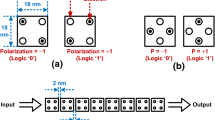Abstract
The quantum-dot cellular automata (QCA) computing paradigm is used to implement Rule 110, a unique one-dimensional cellular automata (CA) that has been proven to be Turing complete. A Turing complete architecture is capable of universal computing, which means that it could be used to implement any arbitrary computation. The optimized design of a single Rule 110 cell is presented, first using Boolean algebra and then by the use of QCA cells. This is followed by simulations to verify the correct behavior of the device and a method for efficiently filling a two-dimensional region with a one-dimensional CA device.














Similar content being viewed by others
References
Lent, C.S., Tougaw, P.D., Porod, W.: Bistable saturation in coupled quantum dots for quantum cellular automata. Appl. Phys. Lett. 62(7), 714–716 (1993)
Lent, C.S., Tougaw, P.D., Porod, W.: Bistable saturation in coupled quantum-dot cells. J. Appl. Phys 74(5), 3558–3566 (1993)
Perez-Martinez, F., Farrer, I., Anderson, D., Jones, G.A.C., Ritchie, D.A., Chorley, S.J., Smith, C.G.: Demonstration of a quantum cellular automata cell in a GaAs⁄AlGaAs heterostructure. Appl. Phys Lett. 91(3), 032102 (2007)
Purkayastha, T., Deah, D., Das, K., Ghatak, S.: Towards quantum dot and device implementation with InP–GaAs–InP nanostructure. Nanomater. Energy 5(1), 20–27 (2016)
Cao, L., Altomare, F., Guo, H., Feng, M., Chang, A.M.: Coulomb blockade correlations in a coupled single-electron device system. Solid State Commun. 296, 12–16 (2019)
Lapinte, C., Makhoul, R., Hamon, P., Roisnel, T., Hamon, J.: A tetrairon dication featuring tetraethynylbenzene bridging ligand: a molecular prototype of quantum‐dot cellular automata. Chem. Eur. J (2020). https://doi.org/10.1002/chem.202000910
Christie, J., Forrest, R., Corcelli, S., Wasio, N., Quardokus, R., Brown, R., Kandel, A., Lu, Y., Lent, C.S., Henderson, K.: Synthesis of a neutral mixed-valence diferrocenyl carborane for molecular quantum-dot cellular automata applications. Angew. Chem. 127, 15668–15671 (2015)
Graziano, M., Wang, R., Roch, M., Ardesi, Y., Riente, F., Piccinini, G.: Characterisation of a bis-ferrocene molecular QCA wire on a non-ideal gold surface. Micro Nano Lett. 14, 22–27 (2019)
Ardesi, Y., Pulimeno, A., Graziano, M., Riente, F., Piccinini, G.: Effectiveness of molecules for quantum cellular automata as computing devices. J. Low Power Electron. Appl. 8, 24–42 (2018)
Blair, E.: Electric-field inputs for molecular quantum-dot cellular automata circuits. IEEE Trans. Nanotechnol. 18, 453–460 (2019)
Haughan, K., Niemier, M.T., Porod, W., Csaba, G.: Cellular automata designs for out of plane nanomagnet logic. In: Proceedings of the 2014 International Workshop on Computational Electronics, pp. 1–4 (2014)
Tougaw, P.D., Lent, C.S.: Logical devices implemented using quantum cellular automata. J. Appl. Phys. 75(3), 1818–1825 (1994)
Lent, C.S., Tougaw, P.D.: A device architecture for computing with quantum dots. Proc. IEEE 85(4), 541–557 (1997)
Lent, C.S., Tougaw, P.D., Porod, W., Bernstein, G.H.: Quantum cellular automata. Nanotechnology 4(1), 49–57 (1993)
Wood, J.D., Tougaw, D.: Matrix multiplication using quantum-dot cellular automata to implement conventional microelectronics. IEEE Trans. Nanotechnol. 10(5), 1036–1042 (2010)
Tougaw, D., Khatun, M.: A scalable signal distribution network for quantum-dot cellular automata. IEEE Trans. Nanotechnol. 12, 215–224 (2013)
Schiff, J.L.: Cellular Automata: A Discrete View of the World. Wiley, New York (2011)
Hadeler, K.-P., Müller, J.: Cellular Automata: Analysis and Applications. Springer, Berlin (2017)
Ilachinski, A.: Cellular Automata: A Discrete Universe. World Scientific Publishing, Singapore (2001)
Jackson, J.D.: Classical Electrodynamics. Wiley, New York (1975)
Cook, M.: Universality in elementary cellular automata. Complex Syst. 15(1), 1–40 (2004)
Wolfram, S.: A New Kind of Science. Wolfram Media, Oxfordshire (2002)
Baldwin, A.T., Will, J., Tougaw, D.: Using the full quantum basis set to simulate quantum-dot cellular automata devices. J. Comput. Electron. 18(4), 982–987 (2019)
Acknowledgements
This work was supported by the Leitha and Willard Richardson Professorship of Engineering and the Richardson Summer Research Fellowship, both of which are provided through the Valparaiso University College of Engineering.
Author information
Authors and Affiliations
Corresponding author
Additional information
Publisher's Note
Springer Nature remains neutral with regard to jurisdictional claims in published maps and institutional affiliations.
Rights and permissions
About this article
Cite this article
Tougaw, D., Will, J.D. Designing a Turing-complete cellular automata system using quantum-dot cellular automata. J Comput Electron 19, 1337–1343 (2020). https://doi.org/10.1007/s10825-020-01518-1
Published:
Issue Date:
DOI: https://doi.org/10.1007/s10825-020-01518-1




